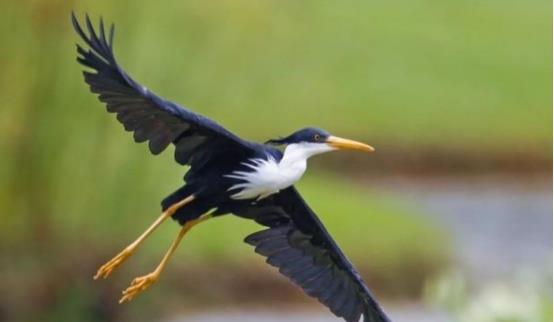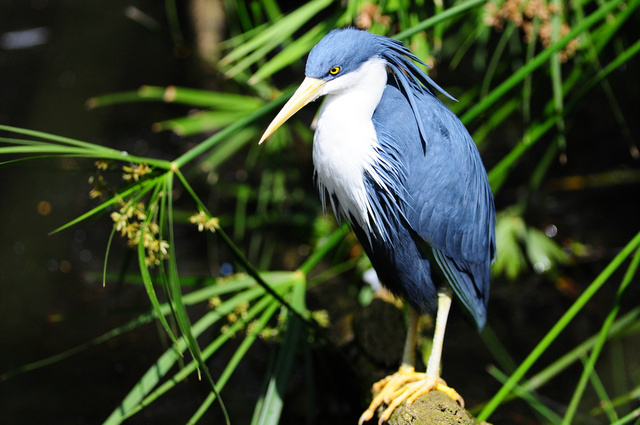Egretta picata
IUCN
LCBasic Information
Scientific classification
- name:Egretta picata
- Scientific Name:Egretta picata,Pied Heron
- Outline:Wading birds
- Family:E.picata Egretta Ardeidae
Vital signs
- length:43-55cm
- Weight:247-280g
- lifetime:
Feature
The lower half of the face and upper chest are white, and the rest of the body is metallic blue-black. During the breeding season, there are white needle-like feathers under the neck. The iris is orange-yellow, and the beak and feet are bright yellow.
Distribution and Habitat
It often lives in swamps, wet grasslands and mangroves near the coast, and feeds on insects, small invertebrates, fish and amphibians.
Appearance
A medium-sized wading bird, 43-55 cm long and weighing 247-280 grams. The top of the head and the size of the body are similar to those of the egret, but the top of the head is blue-black with a crest; the cheeks to the neck are white, with white hooded feathers on the chest, the back and lower body are blue-black, and the bill is yellow. Appearance: forehead, top of the head, crest blue-black; cheeks, chin, throat and neck are white; wings are slate black; back, shoulders, waist to tail are blue-black; lower body is blue-black or slate black; the crest on the top of the head is longer during the breeding season, with long dark lanceolate ornaments on the flap, and long lanceolate ornaments on the lower part of the front neck hanging on the chest. The iris is pale yellow or white; the skin before and around the eyes is cicada blue; the bill is yellow; the tarsus and toes are yellow or orange.
The bill is long and pointed, the wings are large and long, the feet and toes are slender,
Details

The spotted egret (Taiwanese white-necked black egret) (scientific name: Egretta picata) is distributed in Sulawesi, Papua New Guinea, East Timor, Indonesia, coastal and sub-coastal areas of the northern monsoon region of Australia, and the Wallace region. In China, birds are only occasionally seen in Pingtung, Kaohsiung, Taiwan, and parts of Nantong, Jiangsu.
The spotted egret is a medium-sized wading bird, 43-55 cm long and weighing 247-280 grams. The top of the head and body size are similar to those of the egret, but the top of the head is blue-black with a crest; the cheeks to the neck are white, with white hooded feathers on the chest, the back and lower body are blue-black, and the beak is yellow. Appearance: forehead, top of the head, crest blue-black; cheeks, chin, throat and neck are white; wings are slate black; back, shoulders, waist to tail are blue-black; lower body is blue-black or slate black; the crest on the top of the head is longer during the breeding season, with long dark lanceolate ornamental feathers on the flap, and long lanceolate ornamental feathers hanging on the chest at the lower part of the front neck. Iris yellowish or white; the skin around the eyes is blue; the beak is yellow; the tarsus and toes are yellow or orange.
The beak is long and straight, the wings are large and long, the feet and toes are slender, the shin is partially exposed, the three toes are in front and the first toe is behind, and the claw of the middle toe has a comb-like comb edge. Males and females are the same color. The body is spindle-shaped, the body feathers are loose, with silky wing feathers, ornamental feathers on the chest, some have crest feathers on the top of the head, and the legs are feathered.
Like to gather in groups, often in small groups of 3-5 or more than 10 people in shallow water near the water. At night, they gather in large groups of dozens or hundreds in their habitats, and disperse in small groups during the day. They often stand in the water with one foot, and the other foot is bent under the abdomen, the head is retracted to the back like a hunchback, and they stand still for a long time. When walking, the steps are light and steady, and they appear to be unhurried. When flying, the head is retracted to the shoulder, the neck is bent down into a bag shape, the two legs are stretched back and protruded far behind the tail, and the two wings are slowly flapping to fly. Every day after dawn, they fly in groups from their habitats to the foraging grounds, and the distance can reach dozens of miles. In the evening, they fly in groups to the paddy fields and small trees on the hillsides near their habitats to rest. After forming a large group, they enter the woods and bamboo forests together. At night, they roost in groups on the tops of tall trees in small dense forests, and often roost near houses or in garden woods and bamboo forests. They are bold and not afraid of people.
When hunting, the spotted heron is unique. Its strategy for capturing prey is completely different from that of other heron species. It will not wait for a long time. It prefers to run in fast-flowing rivers with its legs nearly half submerged, and use its long and sharp mouth to spear fish. It also eats crustaceans, amphibians, small mollusks, fish, but mostly aquatic insects and their larvae.

This is a small heron, 43-55 cm long, with dark slate wings, body and crowned head, and a white throat and neck. It is similar in appearance to the white-necked heron. Males (247-280 g) are heavier than females (225-242 g), but are similar in appearance.
Juveniles lack the dark color of the crown and head and may look like a small white-necked heron. Juveniles were once classified as a separate species.
Call: The call of the heron is a loud "awk" or "ohrk" in flight. A soft cooing sound is made near the nest. Other sounds are not very informative.
Breeding: The breeding season varies with the distribution area, from February to May in China, with eggs laid in March or April; from October to February in Queensland, Australia, delayed to March to May in dry Australia, and from December to February after migration in Indonesia and New Guinea. Nesting: It builds its nest in a shallow platform made of branches, 4 or 5 meters above the ground, in mangroves or other trees above the water. It usually lives in groups with other herons. Each nest lays 3-4 eggs, which are blue-green, blue without spots, and 41 mm × 31 mm in size. The male and female incubate the eggs together. The chicks are altricial.
Feeding: Its diet includes insects, frogs, crabs, fish and other small aquatic animals. Insects are the most important food source. [5] It can feed alone or in groups, with groups of up to 1,000 individuals.
Distributed in Sulawesi, Papua New Guinea, East Timor, coastal and sub-coastal areas of the northern monsoon zone of Australia, and the Wallace region. In China, it is only occasionally seen in Pingtung, Kaohsiung, Taiwan, and Nantong, Jiangsu.
Listed in the 2013 IUCN Red List of Threatened Species, ver 3.1 - Low Concern (LC).








